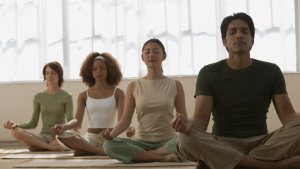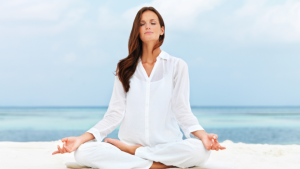A Traveler's Guide to the Soul: Journey Within Wiki Unveiled
A Traveler's Guide to the Soul: Journey Within Wiki Unveiled
Embarking on a journey within is akin to setting forth on an exploration of the soul's vast landscapes. As the soulful adventurer within you seeks to navigate the inner realms, a comprehensive guide has been unveiled—welcome to the "Journey Within Wiki." This traveler's guide to the soul is a treasure trove of insights, practices, and wisdom designed to facilitate your quest for self-discovery and spiritual exploration.
Navigating the Inner Realms
The Art of Meditation
The Art of Meditation" encompasses a profound exploration into the practice of meditation, a timeless and transformative discipline that spans across various cultures and traditions. It is an intricate journey of self-discovery and inner peace, aiming to harmonize the mind, body, and spirit.
At its core, meditation is a contemplative technique that encourages individuals to achieve a state of heightened awareness and mindfulness. The art lies in the ability to cultivate a serene and focused mind amidst the constant stream of thoughts and distractions. Through dedicated practice, one learns to observe thoughts without attachment, fostering a sense of inner calm and clarity.
The artistry of meditation extends beyond mere stress relief; it delves into the realms of spiritual awakening, self-realization, and personal growth. Different meditation styles, such as mindfulness, transcendental meditation, or loving-kindness meditation, offer diverse approaches to attaining mental clarity and emotional balance.
Practitioners often engage in various meditation postures, breath control, and visualization techniques to deepen their practice. The art of meditation is not confined to a specific religious or philosophical framework, making it accessible to people of all backgrounds and beliefs.
As individuals progress in their meditation journey, they may experience heightened intuition, improved concentration, and a profound sense of interconnectedness with the universe. The art lies not only in the technique but also in the consistent cultivation of a positive and compassionate mindset.
Ultimately, the art of meditation is a personal voyage, and each practitioner may find their unique path. It is a discipline that invites individuals to explore the depths of their consciousness, embrace the present moment, and uncover the profound wisdom that resides within. Through the art of meditation, one can embark on a transformative odyssey towards self-realization and inner harmony.
Illuminating Spiritual Practices
Illuminating Spiritual Practices" encapsulates a rich tapestry of transformative rituals and disciplines designed to deepen one's connection with the spiritual dimension of existence. These practices serve as pathways to enlightenment, inner wisdom, and a profound understanding of the self and the universe.
At the heart of illuminating spiritual practices is the pursuit of a higher state of consciousness, transcending the mundane and delving into the sacred. These practices span across diverse cultures, religions, and philosophies, offering individuals a myriad of approaches to explore the spiritual realms.
Meditation, prayer, and contemplation often form the cornerstone of illuminating spiritual practices. Through these methods, practitioners seek to quiet the mind, attune to the divine, and experience a sense of oneness with the cosmos. Meditation, in particular, serves as a powerful tool to illuminate the inner landscape, fostering self-awareness and a connection to the universal consciousness.
Rituals and ceremonies play a significant role in many spiritual traditions. Whether it's the intricate ceremonies of indigenous cultures, the sacraments of established religions, or the personal rituals of individuals, these practices are intended to create a sacred space and invoke the presence of the divine. The use of symbols, sacred objects, and ritualistic gestures contributes to the transformative nature of these practices.
Exploration of sacred texts and spiritual literature is another vital dimension of illuminating spiritual practices. Studying ancient scriptures, philosophical texts, or contemporary spiritual teachings provides seekers with profound insights and guidance on their spiritual journey. The wisdom encapsulated in these texts serves as a beacon, illuminating the path to spiritual awakening and enlightenment.
Mapping the Inner Terrain
a metaphorical exploration that delves into the intricate landscapes of one's inner self, aiming to navigate the complex terrain of thoughts, emotions, and consciousness. This metaphor invites individuals to embark on a journey of self-discovery, understanding, and transformation, much like an adventurer mapping unexplored territories.
The inner terrain encompasses the diverse facets of the human psyche—thoughts, feelings, memories, desires, and the subtle nuances of consciousness. Mapping this intricate landscape involves a deep and introspective inquiry into one's beliefs, values, and the underlying motivations that shape behavior and perception.
Just as a cartographer meticulously charts geographical features, individuals engaged in mapping their inner terrain explore the contours of their thoughts and emotions. This process involves cultivating mindfulness, an acute awareness of the present moment, and an ability to observe thoughts without judgment. Through practices such as meditation, introspection, and self-reflection, individuals can uncover hidden aspects of their inner world.

A group of travelers embarking on a soulful journey within, guided by a Traveler's Guide, meditating in a serene room.
Unveiling the Soul's Expressions
Creative Soulful Expression
Celebration of the profound and authentic ways individuals channel their innermost thoughts, emotions, and spiritual essence into creative endeavors. It encompasses a diverse spectrum of artistic pursuits that serve as vehicles for self-discovery, emotional release, and a deep connection to the soul.
At its core, creative soulful expression involves tapping into the wellspring of creativity within, transcending the boundaries of everyday existence to give form and substance to the intangible aspects of the human experience. This form of expression is not limited to traditional arts but extends to any medium that allows individuals to convey their innermost selves authentically.
Visual arts, such as painting, drawing, and sculpture, provide a canvas for the soul to manifest its intricate landscapes. Through color, form, and texture, artists convey the depth of their emotions, experiences, and perspectives. The act of creation becomes a dialogue between the artist and their inner world, a visual poetry that speaks to the essence of their being.
Similarly, the world of literature and writing becomes a sanctuary for creative soulful expression. Whether through poetry, prose, or storytelling, individuals articulate the complexities of their inner terrain, sharing narratives that resonate with universal truths. Writing becomes a medium for self-reflection, catharsis, and a bridge connecting the internal and external worlds.
Music, with its ability to evoke emotions and transcend language barriers, serves as a powerful avenue for creative soulful expression. Musicians infuse their compositions with the depths of their souls, creating harmonies and melodies that resonate with the listener's own inner experiences. The act of playing or composing music becomes a form of communion with the spiritual realms.
In the performing arts, such as dance and theater, the body becomes a vessel for soulful expression. Movements and gestures convey emotions that words may fail to capture. Performers embody stories and emotions, offering a visceral and transformative experience for both themselves and their audience.
Photography and other visual mediums allow individuals to capture fleeting moments that encapsulate the soul's essence. Through the lens, photographers freeze time, preserving the beauty, pain, and joy of existence. Each photograph becomes a visual poem, a testament to the artist's unique perspective on the world.
The essence of creative soulful expression lies in its authenticity. It is not about conforming to external expectations but about embracing one's unique voice and allowing it to reverberate through the chosen medium. This form of expression becomes a spiritual practice, a way of connecting to the depths of one's being and sharing that connection with the world.
As individuals engage in creative soulful expression, they embark on a journey of self-discovery and personal transformation. It is a continuous exploration, an ever-unfolding process that mirrors the evolution of the soul itself. Through the act of creation, individuals not only express themselves but also contribute to the collective tapestry of human experience, fostering empathy, understanding, and a shared sense of beauty and meaning.
Nature as a Soulful Guide
Connect with the soulful essence of nature as a guide on your journey within. Discover the profound wisdom embedded in natural surroundings and learn to attune yourself to the rhythms of the earth. Nature becomes a mirror reflecting the innate connection between your soul and the universe.
Sacred Soundscapes
Immerse yourself in the soul-stirring world of sound. From chanting and mantra meditation to the harmonies of nature, explore the power of sacred soundscapes in resonating with the vibrational frequencies of your soul. Unveil the healing qualities of sound as you journey within.

A soulful traveler's guide to the journey within, where a woman finds serenity through meditation on the beach.
Community and Shared Soulful Growth
Community Connection
The Journey Within Wiki extends an invitation to join a community of fellow soulful travelers. Engage in discussions, share insights, and connect with kindred spirits on similar paths. The collective energy of community becomes a catalyst for shared growth and mutual support.
Collaborative Soul Projects
Participate in collaborative projects that harness the collective creativity of the community. Contribute to initiatives that celebrate the diversity of soulful experiences, fostering a sense of unity and shared exploration.
Conclusion
As the "Journey Within Wiki" invites you to embark on a transformative adventure into the depths of your being, we recognize the importance of support and guidance on your soulful expedition.
May your journey be a source of self-discovery, spiritual illumination, and a profound connection with the timeless wisdom of your soul. Contact us today and let the "Journey Within Wiki" be your trusted companion on this sacred adventure of self-discovery. Safe travels on the path to inner wisdom and soulful enlightenment!

